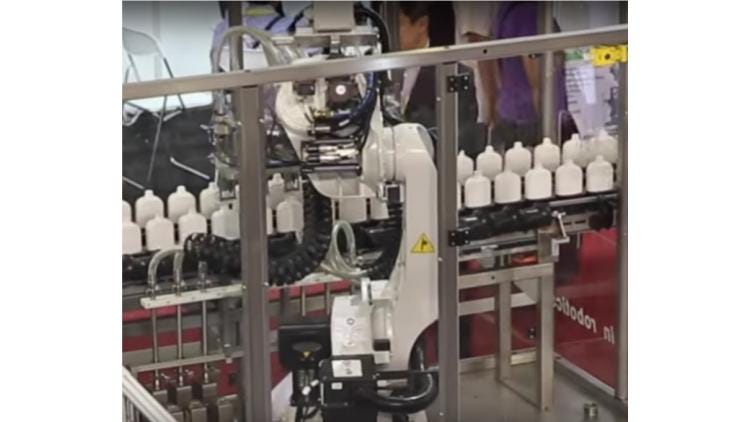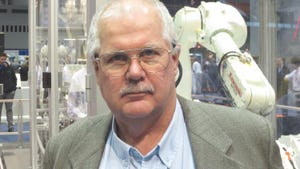June 6, 2019
At the risk of annoying some of my machine-builder friends, I think the current approach to robots and packaging machinery is backwards.
Lots of packaging machines incorporate robots as components. Loading product into cases and cartons is a common application. Any time a standard component, such as a robot, can replace a custom-built component, it is generally a good thing.
It’s not enough.
It has been dawning on me over the past several years that what machine builders should be doing is starting with the robot and building the machine around it. A few companies are doing this already.

FG Industries was the first to give me this idea. It developed a continuous-motion inline filler and capper around a Motoman 6-axis robot. The robot, plus the dispensing system, is the entire filling machine. A second robot (not shown) applies the caps. (Watch video above.)
Another variation on this theme is a system from Australia’s Andrew Donald Design Engineering. A cobot arm from Universal Robots picks a capped vial, places it under a decapping chuck to remove the cap then places the vial under a nozzle for filling. A second cobot takes the vial, reapplies the cap and places it in a tray. (Click here to see a video.)
Bottle orienting is another natural application for robots. This system uses a delta-style robot from Fanuc. Bottles feed at random onto a conveyor. A camera identifies the position and orientation of each bottle and guides the robot. The robot picks the bottle, orients it and places it upright onto a conveyor. (Click here to see a video.)
The Coboxx case erector from XPak is built around a Universal Robots cobot to erect, tape seal the bottom, position cases for loading and send them to a top sealer for closing. The universal articulated gripper allows it to run a range of case sizes with no setup. Add multiple case magazines and it becomes a random-size case erector. (Click here to learn more and see a video.)
The most important advantage to using robots as the basic packaging machine is flexibility. But there are other benefits, as well.
• Speed to market—Most common robot models, especially in the sizes that would be used on a packaging line, are available off the shelf for immediate delivery.
• Standardization—A few dozen makes, models and sizes of robot would cover 80% or so of all packaging machinery applications. This simplifies design, as well as maintenance and operation.
• Cost—Robot prices have dropped dramatically in recent years. Epson offers a SCARA robot, suitable for a small filler or bottle orienter, for less than $8,000. Even a larger robot, as used for the FG filler and capper, is in the $50,000 price range. Compare that to the cost of building a similar packaging machine from scratch.
• Reusability—60% to 80% of all new products fail. When they do, it may be hard to sell the purpose-built machine you no longer need. A robot used for filling can be repurposed as a case packer just by changing the end of arm tooling.
These are just a few examples that are currently on the market. More are coming.
When I was younger, I was promised that we would have flying cars and robots in the 21st century. I am still waiting for my flying car, but robots are here, now. Machine builders can’t be timid about using them. If they don’t convert their machines to robots, someone else will.

Known as the Changeover Wizard, John R. Henry is the owner of Changeover.com, a consulting firm that helps companies find and fix the causes of inefficiencies in their packaging operations. He has written the book, literally, on packaging machinery (www.packmachbook.com) and is the face and personality behind packaging detective KC Boxbottom, the main character in Adventures in Packaging, a popular blog on packagingdigest.com. He can be contacted at [email protected].
********************************************************************************
EastPack 2019 (June 11-13) is the region's premier packaging event connecting professionals from companies like PepsiCo, Pepperidge Farms and Mars with suppliers offering the latest packaging technologies, including a range of automation solutions, from semi-automatic equipment to sophisticated "smart" systems. Register to attend today!
You May Also Like


